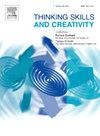Cross-cultural comparison of creative thinking in mathematics textbooks: A case study of high school mathematics textbooks in China, Japan, and South Korea
IF 4.5
2区 教育学
Q1 Social Sciences
引用次数: 0
Abstract
Creative thinking is the core of students' creativity in the digital intelligence era and is crucial for developing students' mathematics literacy. In the mathematics curriculum, tasks in textbooks serve as a vital vehicle for cultivating students' creative thinking and have become a consensus in education reform across many countries. Analyzing the differences in how students' creative thinking develops in mathematics textbooks from different nations has gained increasing attention from the academic community. Students in China, Japan, and South Korea consistently outperform their Western counterparts in mathematics, and each country's educational development path is distinct. Accordingly, this study employed a continuous comparison method (Glaser & Strauss, 1967) to modify Hadar and Tirosh's (2019) creative thinking framework, creating an analysis model suited for examining creative thinking tasks in high school mathematics textbooks. This model includes fourteen sub-categories across three broad themes: divergent thinking, convergent thinking, and horizontal thinking. The comparative analysis reveals that the mathematics tasks in textbooks from these three countries emphasize different aspects of developing students' creative thinking. Additionally, this research offers valuable insights for educators seeking to understand the variations in creative thinking within high school mathematics textbooks across nations. It also provides guidance for future textbook development—such as increasing both the number and proportion of creative thinking tasks, including more interdisciplinary creative thinking exercises—to further foster students' creative thinking abilities.
数学教科书中创造性思维的跨文化比较——以中日韩高中数学教科书为例
创造性思维是数字智能时代学生创造力的核心,是培养学生数学素养的关键。在数学课程中,教材中的任务是培养学生创造性思维的重要工具,已成为许多国家教育改革的共识。分析不同国家数学教科书中学生创造性思维发展的差异越来越受到学术界的关注。中国、日本和韩国的学生在数学方面一直优于西方学生,而且每个国家的教育发展道路都是不同的。因此,本研究采用连续比较法(Glaser &;Strauss(1967)修改了Hadar和Tirosh(2019)的创造性思维框架,创建了一个适合检查高中数学教科书中创造性思维任务的分析模型。该模型包括14个子类别,横跨三大主题:发散思维、收敛思维和水平思维。对比分析表明,三国教科书中的数学任务强调培养学生创造性思维的不同方面。此外,这项研究为试图了解各国高中数学教科书中创造性思维差异的教育工作者提供了有价值的见解。为今后教材的发展提供了指导,如增加创造性思维任务的数量和比例,包括更多跨学科的创造性思维练习,以进一步培养学生的创造性思维能力。
本文章由计算机程序翻译,如有差异,请以英文原文为准。
求助全文
约1分钟内获得全文
求助全文
来源期刊

Thinking Skills and Creativity
EDUCATION & EDUCATIONAL RESEARCH-
CiteScore
6.40
自引率
16.20%
发文量
172
审稿时长
76 days
期刊介绍:
Thinking Skills and Creativity is a new journal providing a peer-reviewed forum for communication and debate for the community of researchers interested in teaching for thinking and creativity. Papers may represent a variety of theoretical perspectives and methodological approaches and may relate to any age level in a diversity of settings: formal and informal, education and work-based.
 求助内容:
求助内容: 应助结果提醒方式:
应助结果提醒方式:


